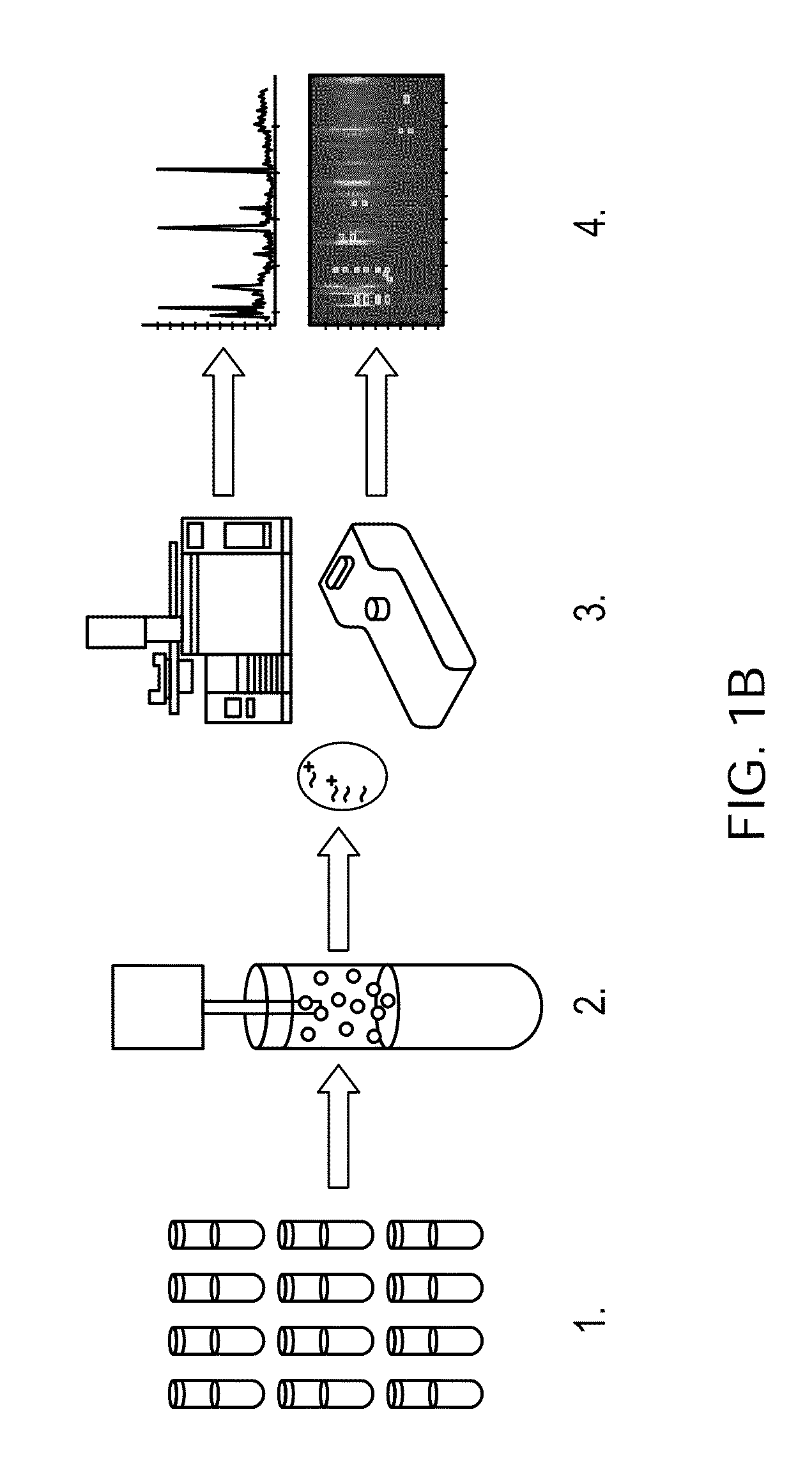Rapid detection of volatile organic compounds for identification of Mycobacterium tuberculosis in a sample
a technology of volatile organic compounds and mycobacterium tuberculosis, which is applied in the field of rapid detection of volatile organic compounds for the identification of mycobacterium tuberculosis in a sample, can solve the problems of increasing global health problems, bacterial contamination, and the spread of drug-resistant bacteria, and achieve the effect of improving bacterial burden and/or efficacy, and facilitating detection of vocs
- Summary
- Abstract
- Description
- Claims
- Application Information
AI Technical Summary
Benefits of technology
Problems solved by technology
Method used
Image
Examples
example 1
Exemplary Method for Identifying and Detecting Exemplary Volatile Organic Compounds in a Headspace Sample Following Incubation of Mycobacterium tuberculosis
[0088]General Experimental Procedure:
[0089]Mycobacterium tuberculosis RV laboratory strain (Mtb RV strain) was incubated in a minimal media containing four carbon sources (cholesterol 0.01% w / v, sodium propionate 0.1% w / v, sodium pentanoate (valerate) 0.1% w / v, and sodium hexanoate (caproate) 0.1% w / v). Then, the Mtb RV strain was resuspended in the media and the headspace was incubated for 24 h at 37° C. Following this incubation the headspace was extracted for 30 minutes onto a SPME fiber (PDMS / DVB / Carboxen) that was then analyzed on a dual GC-MS / DMS instrument. This experiment was repeated three times with 5 replicates / sample. Samples containing media alone were compared to samples containing the Mtb. Peaks that were present in the Mtb containing samples but not media alone were identified using a National Institute of Standa...
example 2
Further Exemplary Method for Identifying and Detecting Exemplary Volatile Organic Compounds in a Headspace Sample Following Incubation of Mycobacterium Tuberculosis
[0093]General Experimental Procedure:
[0094]An Mtb culture and M. smegmatis culture (control) were incubated in minimal media containing sodium propionate. After the cultures incubated for 24 hours, the volatile organic compounds (VOCs) were extracted from the headspace using solid phase micro-extraction (SPME) fibers. SPME fibers are coated fibers that specifically extract volatiles from the air. See, for example, Pawliszyn Janusz in Solid Phase Microextraction: Theory and Practice (1997, Wiley-VCH) for a further description. Next, the fibers were irradiated with UV light to kill any live bacteria, and then the fibers were packaged on ice and shipped overnight to an analytical laboratory for analysis.
[0095]Compounds adsorbed on the fiber were desorbed in the injection port of a gas chromatograph (GC) and detected by both...
example 3
Identification of Volatile Organic Compounds in a Headspace Sample Following Incubation of Four Clinical Strains of Mycobacterium Tuberculosis
[0099]General Experimental Procedure:
[0100]Four clinical strains of Mtb were grown to a concentration of 108 bacilli / mL and re-suspended in minimal media containing sodium propionate, cholesterol, sodium pentanoate, and sodium hexanoate. After the bacteria were incubated for 24 hours, volatile organic compounds (VOCs) were extracted from the headspace and analyzed according to the general experimental procedures described in Examples 1 and 2. The four clinical strains of Mtb used in this experiment were i) CDC1551 which is a virulent clinical strain from lineage 4 (See, Gagneux et al. in Lancet Infect. Dis. (2007) vol. 7, pages 328-337), ii) HN878 which is a strain from East Asia that is also known as the “Beijing” strain (See, Gagneux et al. in Lancet Infect. Dis. (2007) vol. 7, pages 328-337), iii) 6-247 which is a clinically derived strain...
PUM
| Property | Measurement | Unit |
|---|---|---|
| time | aaaaa | aaaaa |
| time | aaaaa | aaaaa |
| time | aaaaa | aaaaa |
Abstract
Description
Claims
Application Information
 Login to View More
Login to View More - R&D
- Intellectual Property
- Life Sciences
- Materials
- Tech Scout
- Unparalleled Data Quality
- Higher Quality Content
- 60% Fewer Hallucinations
Browse by: Latest US Patents, China's latest patents, Technical Efficacy Thesaurus, Application Domain, Technology Topic, Popular Technical Reports.
© 2025 PatSnap. All rights reserved.Legal|Privacy policy|Modern Slavery Act Transparency Statement|Sitemap|About US| Contact US: help@patsnap.com



